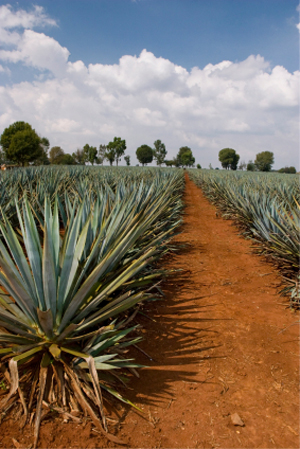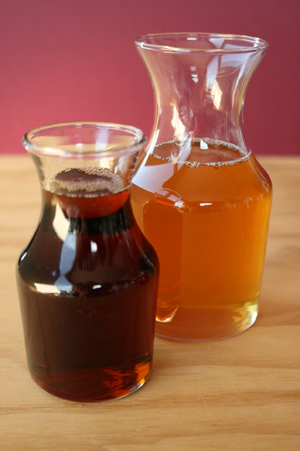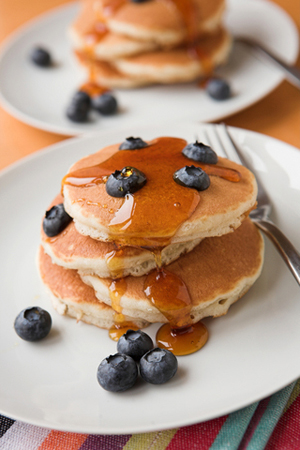 |
| |

A field of blue agave. The sap comes from the piña at the base of the plant (not shown). Photo by Cristian Lazzari | IST. |
| WHAT IT IS: A great natural sweetener. |
| WHY IT’S DIFFERENT: Agave nectar has half the glycemic index of sugar, a boon for diabetics and anyone who wants to cut back on sugar calories and sugar blues. Currently in liquid form only. |
WHY WE LOVE IT: Nicer-tasting than refined white sugar; dissolves easily in cold beverages; saves a lot of calories and carbs; a healthy sweetener. |
| WHERE TO BUY IT: At natural food stores and health food stores nationwide (check supermarkets, too); and online. See products below. |
|
|
 |
 Agave Syrup Agave Syrup
Page 2: How It’s Made, How To Use It
How Agave Nectar/Agave Syrup Is Made
While some agave syrups are made from a combination of agave plants, the best are 100% Weber Blue Agave—a species with a higher carbohydrate content, which results in a high percentage of fructose (as opposed to sucrose) in the final nectar (and a sweeter nectar). Fructose is a lower glycemic sugar than sucrose (which is table sugar—see our Sugar Glossary).
At the base of the plant is the core/heart known as the “piña”—because it looks like a huge white pineapple. It grows half above ground and half below, and can weigh from 50 to 150 pounds; the plant takes 8 to 10 years to mature). The piñas are harvested by a specialist called the jimador.
The piña is used to make both agave syrup and tequila.
- In the case of tequila, the piña hearts are split open and steamed in large pressure cookers.
- The liquid that results is fermented in steel tanks and then distilled. This silver or “blanco” tequila is then distilled to achieve 80 proof.
- It is then bottled or aged in oak barrels to create a reposado or an añejo tequila. (Here’s more about the types of tequila.)
- To make agave syrup, the piña is chopped up to release the juices, which are filtered and heated at a low temperature, then bottled. Heating breaks down the carbohydrates into sugars.
- Because the processing takes place at temperatures lower than 118°F, agave syrup is regarded as a raw food.
Another benefit: agave syrup is lighter and less sticky than honey or maple syrup. It pours easily out of the bottle.
How can you best use agave syrup/agave nectar?
The article continues below. below. |
INDEX OF REVIEW
This is Page 1 of a two-page review. Click on the black links below to visit other pages:
|
MORE TO DISCOVER
|
How To Use Agave Syrup
First remember that agave syrup is 25% to 50% sweeter than sugar, so start by using less of it. You’ll get to know how much you like in your beverages and in recipes.
Next, it’s important to know that agave syrup is available in light, amber, dark and raw varieties.
- Light agave syrup has a mild, almost neutral flavor, although some brands taste like very light honey. It is best used to sweeten delicate foods like fruit salad, and beverages. Raw agave syrup is similar in flavor, and guarantees raw foodists that the natural enzymes are protected.
- Amber agave syrup has a caramel flavor, and is therefore used in foods and drinks with stronger flavors.
- Dark agave nectar has stronger caramel notes and imparts a distinct flavor to dishes. It’s best as a pancake syrup, in marinades and glazes and in desserts that should be enhanced with a caramel-brown sugar sweetness.
Unlike honey, agave syrup doesn’t crystallize!
Here are our favorite ways to use agave syrup.
|
 |

Agave sap is made into light, dark and amber varieties, plus a raw agave syrup similar to the light variety. Photo of Wholesome Sweeteners light and dark agave syrup by River Soma | THE NIBBLE. |
- In Any Beverages. Agave nectar dissolves equally well in hot and cold beverages, including cocktails.
- As A Syrup. Use agave as an alternative to sugar- and corn syrup-based syrups. Dark agave syrup is our favorite on pancakes, waffles, French toast and anyplace you’d sprinkle brown sugar.
- Cereals. We used to douse both hot and cold cereal with no-calorie Splenda. Concerned with the unknown long-term effect of this processed product, we went “natural” and now use a squeeze of light agave syrup.
- Cooking & Baking. Substitute 1/4 cup of agave for 1 cup of sugar. You may need to experiment since agave is liquid and may change the cooking times and textures. VegFamily.com suggests the following:
(1) If you substitute agave for sugar in a recipe, use 2/3-3/4 the original amount of sweetener.
(2)
Decrease the original liquid in the recipe by 25% to 33% (thus, if a recipe calls for one cup of sugar and one cup of milk, add only 2/3-3/4 cup agave syrup andy 3/4 cup milk).
(3)
Agave, like honey, will burn more easily than sugar, so decrease the oven temperature by about 25°F.

|
|

Use agave syrup as a low-glycemic topping on pancakes, waffles and French toast. Photo by D.K. Gilbey | Dreamstime. |
You’ll remember 2011 as the year you discovered agave syrup.
Go To The Article Index Above
Do you have friends who would enjoy THE NIBBLE?
Click here to send them an invitation to sign up for their own copy. |
© Copyright 2004-2026 Lifestyle Direct, Inc. All rights
reserved. All information contained herein is subject to change at any time
without notice. All details must be directly confirmed with manufacturers, service
establishments and other third parties. The material in this e-zine may not
be reproduced, distributed, transmitted, cached, or otherwise used, except with
the prior written permission of Lifestyle Direct, Inc.
|
|

|
 |